|
Synbiotic (Prebiotic / Probiotic) / Complete Mineral Formula
The Most Complete Supplement of its Kind
With 38 Different Probiotic Strains
Over 80 Trace Minerals / Elements
Blended in a Proprietary Prebiotic Mix


Code 710A - Net: 3.45 Oz. (98 g.)
Serving Size: 1/2 tsp. (1,550 mg. minimum)
Servings Per Day: 1 / Per Container: 63
Two Months Supply - $47.50
Product Label
[ Directions: Gently stir 1/2 tsp. into small glass of water or juice, and drink.]
 n 2002, we introduced
Microflora Restore, what to that time was the broadest,
most complete probiotic yet introduced on the market. (It was a component of our
Liver / Colon Cleansing Program.)
The product was so well-received by customers that for years after
Microflora Restore was made unavailable, customers begged to see the product returned.
 During these intervening 15 years, many
things have changed -- not the least of which is the emergence of a burgeoning
probiotic market that seeks to address the ecological and epidemiological
nightmare that has been created by a food system awash in toxic rescue chemistry
1 ---
herbicides, pesticides, insecticides, fungicides, etc. and their metabolites, poisoning
the general public and polluting water supplies
2 --- of which the most damaging may be Roundup glyphosate.
3 Added to this is the plague of increasingly stronger
antibiotics and their metabolites, which also contribute to the problem.
4
 All animals, humans included, have a symbiotic
relationship with microbes.
5 In fact, there are vital nutrients that humans cannot
obtain in proper quantities without them.
6 As the food supply has become increasingly
hostile to the maintenance of proper microbial balance, so has the need for probiotic
and prebiotic supplementation in order to ward off the diseases and degenerative
conditions that microbial imbalance inevitably brings.
7 Although proper food selections
and reliance on organic sources can help minimize these effects, they by no means
provide complete protection. 8
Why Probiotics Need Minerals &
Why Good Mineral Absorption Requires Probiotics
 It has been known for many years that bacteria, the
microscopic animals that they are, have mineral nutritional requirements, just like we do.
9
It has also been established that microbes are ubiquitous in our geophysical environment and
among its most transformative agents, leaving no element untouched.
10 They are even
capable of neutralizing radioactive materials, like cesium, "which they transmute to
stable, non-radioactive elements." 11
 Conversely, those with even an elementary knowledge of probiotics
know that certain bacteria (in this case, Lactobacilli, as found in Microflora Restore)
are vital to human nutrient by enhancing the production of Vitamins A, B2, B3, B5, B6, B12, K,
biotin, and bile acids.
12 Fewer know that bacteria play an important role in making vital minerals
like calcium bioavailable for better assimilation.
13, 14
More recently, it was discovered
that probiotics use indigestible carbohydrates like oligofructose, galactooligosaccharides and inulin
to " bind and sequester the minerals and these carbohydrate-mineral complexes (which) pass unabsorbed through
the small intestine onto the colon where the minerals are released from the complex and absorbed."
15
The Scope of Man's True Mineral Nutrient
Requirements Has Been Dramatically Understated
By Orthodox Nutrition & Regulatory Authorities
 What does officialdom include in our daily mineral requirements?
To the present date, the only minerals recognized as
warranting consideration as human nutrients and/or nutritional labelling by the orthodox community
are: boron, calcium, chromium, copper, fluoride, iodine, iron, magnesium, manganese, molybdenum,
nickel, phosphorus, selenium, vanadium, and zinc, or fifteen elements. 16
The USDA recognizes the following minerals as nutrients: calcium, copper, flouride, iron,
magnesium, manganese, phosphorus, potassium, selenium, sodium, and zinc, or eleven elements.
17
By contrast, the U.S. FDA, for the purposes of labelling, recognizes the following:
sodium, potassium, calcium, iron, phosphorus, iodine, magnesium, zinc, selenium, copper,
manganese, chromium, molybdenum, and chloride, or fourteen elements.
18 Were one to
believe these institutions, one would conclude that man's mineral nutritional needs are on par
with house plants. 19
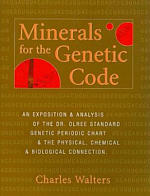
 What a coalescence of time, thought, observation, experimentation,
and genius have taught us, however, is that we are not house plants. For optimal health, our needs are
different. Our mineral requirements are much more varied, something that is reflected in the omnivorous human
dietary smorgasbord that one finds as they travel the world. 20
 The human genome doesn't call for 11 or 14 or 15 officially-recognized
minerals. It calls for at least 64 . . . and the probiotics necessary to maximize their absorption.
21
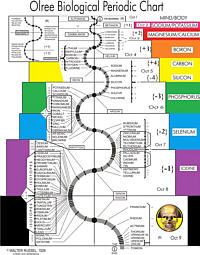
 Many of the most vital minerals necessary for normal
human function are not even recognized by officialdom -- not by government officials,
dieticians, nutritionists, or the rest of the official medical establishment. Indeed, the average person
is not even familiar with these minerals, if they have heard of them at all -- ever. And, of course,
examples abound:
 For example, yttrium (element 39) is vital to normal
brain function -- whose absence or deficiency leads to the body choosing calcium as a substitute,
which itself leads to calcification. Lou Gehrig's disease, Alzheimer's, multiple sclerosis, and
Parkinson's disease "all relate to yttrium deficiency."
22 (These conditions respond to yttrium-based
Bifidobacterium bifidum, an important bacterium in the Microflora Restore II formula.)
 Another completely overlooked mineral -- critical to human
functioning, is lanthanum (element 57). Our DNA code "calls for mass amounts of the stuff."
So vital is this element that it is called for
36,356,923 times in the sequenced genome -- that we know of. 23
 Vanadium Vanadium (element 23) was proven to be an essential mineral
in 1971, and its deficiency is associated with "slow growth, increased infant mortality, infertility,
elevated cholesterol, elevated triglycerides, hypoglycemia, hyperinsulinemia, diabetes, cardiovascular
disease, and obesity." 24
 It is beyond the scope of product introduction to delineate every
human mineral need, but it is worth noting that even mineral supplementation advocate, Dr. Joel Wallach, whose
work preceded that of Dr. Richard Olree by over a decade, noted that of the 79 minerals detected in human
and animal tissue, at least 60 were worth considering as "essential." This statement is supported by
thousands of scientific studies. 25
 All these "proposed" essential minerals play prominently
in the Microflora Restore II formula, coming from four separate mineral sources -- three of them
concentrated sea vegetables from Iceland and Maine: Norwegian kelp (Ascophyllum nosodum),
Bladderwrack (Fucus vesiculosus), Oarweed (Laminaria digitata),
and "Middle Earth" mineral salts from Ecuador. Note: the sea vegetables used in
Microflora Restore II are Certified Organic.
The Importance of Prebiotics:
Putting It All Together
 In addition to its mineral probiotic support,
Microflora Restore II contains a superior, bioactive form of Leonardite
(with a 15% fulvic acid content) to help feed and nourish the probiotics in the formula.
Our humate source is fossilized peat, derived from ancient freshwater plants. It is
highly bioactive, unlike other forms of Leonardite, which have broad industrial applications,
but are less unsuitable for human consumption, if suitable at all.
 Additionally, we include this form of humate,
because it is effective in sequestering heavy metals, which can be found
even in organically-grown sea vegetation.
26
 Based on all currently available research --
now 15 years since the introduction of our first probiotic -- we feel this is the best combination
for a fully functioning, broad-based probiotic / prebiotic / mineralization
formula.
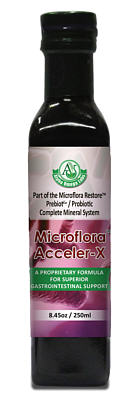

Code 711C - 8.45 fl. oz. (250 ml.)
48 Servings (48 Day Supply) - $26.50
Take one tsp. (5 ml.) daily, mixed in
a small glass of water or juice
Product Label
 icroflora Acceler-X icroflora Acceler-X is a stand-alone,
"full-spectrum" prebiotic -- (see "Primer" article below). We created this product for those who simply
want an "easy-to-take" prebiotic to support the body's
existing intestinal microflora.
 [ Active Ingredients: Purified Water, acacia gum
(gum arabic) 27,
agave inulin 28,
galacto-oligosaccharides 29,
guar gum 30. Minor ingredients and
excipients: zinc sulfate, magnesium sulfate, ferrous sulfate, potassium sorbate,
citric acid, and boric acid. ]
A Quick Primer On Prebiotics
 Stated in its simplest terms, prebiotics are fermentable
plant fibers that feed the good bacteria that is already in the lower gastrointestinal
tract. 31 By doing this, prebiotics improve the good-to-bad ratio of bacteria in the gut.
Plant fibers, as you find in Microflora Acceler-X, pass through the small intestines
undigested, and, depending on the type, nourish bacteria at various locations throughout
the colon, which itself has anywhere between 400-500 different species of bacteria
and more than 7,000 strains. 32 Among the many benefits conferred
by a full-spectrum prebiotic, like Microflora Acceler-X, are:
- Better mental health
- Better immune function
- Improved vitamin and mineral production and absorption
- Improved regularity
- Improved bone density
- More energy / less fatigue
- Less inflammation
- Less appetite, making it easier to lose weight
- Positive effects against gastritis and leaky gut
- Among many others . . .
 We call "Acceler-X" a "full-spectrum" prebiotic,
because it nourishes bacteria that thrive in the early stages of the colon
(i.e. galacto-oligosaccharides: cecum to transverse colon), later stages of the colon
(i.e. inulin: traverse to sigmoid), and intermediate stages (acacia and guar gums).
 Prebiotic Foods: Prebiotic Foods: Although a well-designed prebiotic can have
dramatic effects on improving intestinal flora, it also helps to include more "prebiotic" foods in the
diet. About 5 grams of plant-based "prebiotic fiber" per day is recommended. These are listed below with
the approximate percentage of prebiotic-containing fiber:
- Raw chicory root (>64%)
- Raw Jerusalem artichoke (>31%)
- Raw dandelion greens (>24%)
- Raw garlic (>17%)
- Raw leeks (>11%)
- Raw onion (>8%)
- Cooked onion (>5%)
- Raw asparagus (5%)
- Raw wheat bran (5%)
- Raw banana (1%)
Footnotes
- "Toxic rescue chemistry" is a term frequently used by the late
Charles Walters
and is central to the organization he left behind,
Acres USA. It describes the array of artificial
soil amendments that became the center piece of modern farming following WW II. One day people will look
back at our era and wonder how we could have thought we could employ such a vast array of toxic chemicals
on our fields and somehow, as if by magic, this poisoning of the earth would not end up poisoning us . . .
- The residue from PPCP's (pharmaceutical and personal care products) in the water table is
well-documented. (See also,
Washington
Hydrogeological study (2012)
- See the Institute of Science in Society's report,
Why Glyphosate
Should Be Banned. See Scientific American, "
(Glyphosate)
Proves Deadling to Human Cells." (2009) or report by BioMed Central,
Concerns over use of glyphosate-based herbicides and risks associated with exposures:
a concensus statement. On a more personal note, the decision to hasten the introduction of
Microflora Restore II and Microflora Acceler-X
- See report by YaleEnvironment360,
As Pharmaceutical Use Soars, Drugs Taint Water and Wildlife. Although the EU's
Science for Environment Policy's
Environmental concentrations of antibiotics are potentially damaging to aquatic life seems limited in
scope, it is obvious that the proliferation of antibiotics and their metabolites are damaging across all
ecosystems. In 2015, The Scientist weighted in with
Drugging the Environment, which states
"Antibiotics in the environment promote antibiotic resistance in a range of bacterial species,
and endocrine disruptors are known to affect development and reproduction in animals."
It becomes evident that each person has to guard themselves against this growing threat
when completing the fact that environmental agencies (or at least the U.S. EPA cited in the article)
"does not regulate even a single human pharmaceutical in drinking water." In all of this we should recognize
that the war against microbes is a microcosm of our Age's war against nature: competition vs. cooperation.
See also Marc Lappe's Germs That Won't Die: Medical Consequences of the Misuse of Antibiotics,
ISBN:0-385-15093-8.
- See Host Bacterial
Symbiosis in Health and Disease (2010)
- See
Effects of Gut Microbes on Nutrient Absorption and Energy Regulation (2012).
So also
Contributions of Intestinal Bacteria to Nutrition and Metabolism in the Critically Ill --
this latter article breaks down microbiota's effects by nutrient group.
- Walters, Charles, Fertility from the Ocean Deep, Acres USA, Austin, Tx, 2005; p. 73-77. ISBN: 978-0-911311-79-2.
Schroeder, Henry A., M.S., The Trace Elements and Man: Some Positive and Negative Aspects, Devin-Adair Company,
Old Greenwich, CT, 1973; Chap. 2: The Beginnings of Life and Its Development to Man. LOC 72-85732.
- Wallach, Joel D. BS, DVM, ND; Ma Lan, MD, MS, Rare Earths: Forbidden Cures, Double Happiness
Publishing Co., Bonita, Ca, 1994. ISBN 0-9701490-8-5. The entire monogram is a tour-de-force on the vital
role of minerals, macro and trace, that are missing from the modern diet, and the fact that "the elemental
raw materials of life (are) no longer found in our food." (p. xix)
- Years ago, one group of researchers focused on LAB (lactic acid bacteria) and found that minerals
increased the strength, power, and resourcefulness of these organisms. "(Their)
. . . investigations have shown that potassium is required for growth of Streptococcus faecalis,
and Lactobacillus casei, while magnesium and manganese are essential for growth of Lactobacillus plantarum
and is Lactobacillus casein, and various other lactic acid bacteria." Orla-Jensen,
S., K. Danske Vidensk. Selak., Biol. Skrifter, 2, No. 3, 1943. More controversially,
Professor C. Louis Kervran shows that bacterial agents were huge contributors to a
process of "biological transmutation," changing elements one to another, in accordance
with the needs of the host. (I first wrote about this in discussing
how Bone Builder worked in 2002.)
However, a plentitude of the right minerals adds to the building blocks that bacteria have to work with,
in addition to insuring their optimal nutrition.
- " . . . virtually all elements in the periodic table (including actinides, lanthanides,
radionuclides) can be accumulated by or be associated with microbial biomass depending on the
context and environment." Metals, minerals, and microbes: geomicrobiology and bioremediation
Geoffrey Michael Gadd, Division of Molecular Microbiology, College of Life Sciences, University of Dundee,
Dundee, UK. Microbiology (2010), 156, p. 609-643. Citation taken from p. 610.
- This finding was the result of the work of Ukrainian scientists, Vladimir Vysotskii and
A. Kornikova. See:
Edmund
Storms on "Biological Transmutation."
- Chaitow, Leon and Treney, Natasha. Probiotics: How Live Yogurt and Other 'Friendly Bacteria'
Can Restore Health and Vitality, Hohn Press, Scottsdale, AZ. (1995). p. 40-41.
See also:
Role of intestinal bacteria in nutrient metabolism (Sage Journals / 1997).
- href="https://www.hindawi.com/journals/tswj/2014/595962/" target="_blank">
Effect of Probiotics Supplementation on Bone Mineral Content and Bone Mass Density (2014)
- Bacteria produce phytaze enzyme,
which can release minerals depressed by phytate, resulting in increased availability of minerals including calcium
See :
Efficacy of supplementation of a phytase-producing bacterial culture on the performance and nutrient use of
broiler chickens fed corn-soybean meal diets.
- "Role of probiotics in facilitating mineral absorption" under
Probiotics 101: What Effect Can Probiotics Cause On Mineral Absorption
-
Dietary Reference Intake (DRI's): Elements. Issued by the U.S. Food & Nutrition Board, Institute of Medicine,
National Academies.
- USDA Food Composition Databases,
-
U.S. FDA -- Guidance for Industry: A Food Labeling Guide
- I could pick any number of botanical authorities on this one, but they're all pretty close.
My favorite is Jacob R. Mittleider's The Garden Doctor, who took the time to meticulously
study the effects of deficiency of each of a plant's required fifteen elements: nitrogen, calcium,
phosphorus, chlorine, potassium, magnesium, copper, manganese, zinc, sulfur, iron, boron, and molybdenum.
- Years ago I was struck by the dissimilarity
of diets of indigenous people that Dr. Weston Price covered
in his landmark work, Nutrition & Physical Degeneration (1939). Yet they all had in
common unique elements of proper mineral and probiotic inputs.
- Walters, Charles. Minerals for the Genetic Code, Acres U.S.A., Austin, TX. (2006). p. 63.
- Ibid., p. 62.
- Ibid., p. 63, 95.
- Ibid., Wallach, Joel D., Rare Earths: Forbidden Cures, p. 412.
- Wallach, Joel D., Dead Doctors Don't Lie, Legacy Communications Group, Inc., 1999. p. 215.
ISBN 1-880692-40-6.
- See:
Lignitic Humic Acids as Environmentally-Friendly Adsorbent for Heavy Metals, (2017)
See also,
Hungarian Heavy Metal Detoxification Studies of Humic Acid.
-
Gum arabic establishes prebiotic functionality in healthy human volunteers
in a dose-dependent manner. (2008) It should be noted that this study determined an optimal dosage of 10 g/d,
it did not determine the synergistic effects when combined with other prebiotics. See also:
Acacia Gum is a Bifidogenic Dietary Fibre with High Digestive Tolerance in Healthy Humans (2009); among others.
-
Agave Inulin Supplementation Affects the Fecal Microbiota of Healthy Adults Participating in a Randomized,
Double-Blind, Placebo-Controlled, Crossover Trial (2015);
Inulin-type fructans of longer degree of polymerization exert more pronounced in vitro prebiotic effects (2006);
Production of Fructooligosaccharides from Inulin by Endoinulinases and
Their Prebiotic Potential (2010); among others.
-
Supplementation of Diet with Galacto-oligosaccharides Increases Bifidobacteria,
but not Insulin Sensitivity, in Obese Prediabetic Individuals (2017);
Prebiotic inulin-type fructans and galacto-oligosaccharides: definition, specificity,
function, and application in gastrointestinal disorders (2017); among many others.
-
In vitro analysis of partially hydrolyzed guar gum fermentation on identified gut microbiota (2016);
Prebiotic Effects and Fermentation Kinetics of Wheat Dextrin and Partially Hydrolyzed Guar Gum in
an In Vitro Batch Fermentation System (2015);
Consumption of partially hydrolysed guar gum stimulates Bifidobacteria and butyrate-producing
bacteria in the human large intestine (2015); among others.
-
Relationship of prebiotics and food to intestinal microflora, European Journal of Nutrition, October 2002,
Volume 41, p. i11-i16.
- Charalampopoulos, Dimitris; Rastall, Robert A. (ed.);
Prebiotics and Probiotics Science and Technology, Springer Reference, New York, 2009.
ISBN: 978-0-387-79059-6. p. 10.
|
 Deep in the Andeans highlands of Central Ecuador
rests the small village of Salinas de Guaranda. I have never met a healthier, happier, or
more fun-loving lot of people. When I visited in February (2017), I saw a small boy, probably
not even four years old, riding his alpaca about two kilometers outside of town. No one else was
in sight. He was out on the lonely road all by himself with his alpaca. The animal was
heavily weighed down with supplies and the boy used both hands to keep provisions in place.
Subtle signs of this kind of vitality permeate the village. As you read below . . . the secret of
these Andeans is their mineral supplementation and the biotics in their diet. One of the
components of Microflora Restore II is the dehydrated mineral salt that locals tout
for its health benefits. This mineral salt is known to spring up from beneath nearby
Chimborazo, the world's
highest mountain as measured from Earth center. Deep in the Andeans highlands of Central Ecuador
rests the small village of Salinas de Guaranda. I have never met a healthier, happier, or
more fun-loving lot of people. When I visited in February (2017), I saw a small boy, probably
not even four years old, riding his alpaca about two kilometers outside of town. No one else was
in sight. He was out on the lonely road all by himself with his alpaca. The animal was
heavily weighed down with supplies and the boy used both hands to keep provisions in place.
Subtle signs of this kind of vitality permeate the village. As you read below . . . the secret of
these Andeans is their mineral supplementation and the biotics in their diet. One of the
components of Microflora Restore II is the dehydrated mineral salt that locals tout
for its health benefits. This mineral salt is known to spring up from beneath nearby
Chimborazo, the world's
highest mountain as measured from Earth center.
[Click to enlarge.]
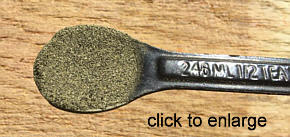
 Don't overdue it. You only need 1/2 tsp. per day
to experience the "Microflora Restore" effect, within two to three days, on average.
What's In
Microflora Restore II?
 As was the case with
the original Microflora Restore formula, the beneficial bacteria
in Microflora Restore (listed below by species) are
all Class I bacterial agents as
rated
by the American Type Culture Collection Catalogue (301-881-2600)
in Rockville, Maryland (USA). (Thus, even in the U.S.,
they are legal under the Federal Register, Vol. 54 #38,
1989). Class 1 bacteria are rated as "of no or minimal
hazard under ordinary conditions."
Primary Probiotic Nutrients
- Bacillus amyloliquefaciens
- Bacillus licheniformis
- Bacillus mojavensis
- Bifidobacterium bifidum
- Bifidobacterium lactis
- Brevibacillus laterosporus
- Lactobacillus casei
- Lactobacillus paracasei
- Lactobacillus plantarum
Secondary Probiotic Nutrients:
(SBO's): Soil-based Organisms
- Acinetobacter calcoaceticus
- Arthrobacter agilis
- Arthrobacter citreus
- Arthrobacter globiformis
- Arthrobacter leuteus
- Arthrobacter simplex
- Azotobacter chroococcum
- Azotobacter paspali
- Azospirillum brasiliencise
- Azospirillum lipoferum
- Bacillus brevis
- Bacillus macerans
- Bacillus pumilus
- Bacillus polymyxa
- Bacillus subtilis
- Bacteroides lipolyticum
- Bacteroides succinogenes
- Brevibacterium lipolyticum
- Brevibacterium stationis
- Kurtha zopfil
- Myrothecium verrucaria
- Pseudomonas calcis
- Pseudomonas dentrificans
- Pseudomonas flourescens
- Pseudomonas glathei
- Phanerochaete chrysosporium
- Streptomyces fradiae
- Streptomyces cellulosae... and...
- Streptomyces griseoflavus
Average Microbiological
Assay / Standard
- Coliforms -- negative
- E. Coli -- negative
- Salmonella -- negative
Minimum Total
Plate Count
- 4 billion CFU / gram, or over 6 billion CFU per dosage *
* CFU = colony forming units.
In practical terms, the minimum number of separable cells
on the surface of or in semi-solid agar medium which gives rise to
a visible colony of progeny. CFUs may consist of pairs, chains
and clusters as well as single cells. See:
Certificate of Analysis (5/31/2017).
 Microflora Restore II uses a specifically minded
type of leonardite for its primary base material. Our leonardite possesses many of the same functionary
properties as Shilajit in India,
which has been prized for millennia for its curative properties.
 Our leonardite's primary composition is
natural, organic humates, with a high percentage (15%) of bioactive fulvic acid,
upon which healthful bacteria thrive. The primary
constituent of the Leonardite in Microflora Restore II (as there are
different grades) is humic acid, a bio-stimulant and itself the result of
millions of years of organic decomposition. It provides healthy bacteria
with a carbon source for good.
 Microflora Restore II is approximately
48% leonardite.
 Microflora Restore II contains the
following elements and trace minerals, the majority (by weight) in easy-to-absorb
organic form. Some of these, especially the heavier "metals," occur in extremely
minute amounts, measureable in parts per billion, or even smaller -- and yet they
all contribute to the restoration of the genetic code (see main article at left):
- Group I Alkali Metals: Lithium, Sodium, Potassium, Rubidium, and Cesium (5)
- Group II Alkaline Earth Metals: Berylium, Magnesium, Calcium, Strontium, and Barium. (5)
- Group III Transition Metals: Scandium and Yttrium (2)
- Lanthanoids : Lanthanum, Cerium, Praseodymium, Neodymium,
Promethium, Samarium, Europium, Gadolinium, Terium, Dysprosium, Holmium, Erbium, Thulium,
Ytterbium and Lutetium (15)
- Group IV Transition Metals: Titanium, Zirconium and Hafnium (3)
- Group V Transition Metals: Vanadium, Niobium, Tantalum (3)
- Group VI Transition Metals: Chromium, Molybenum, and Tungsten (3)
- Group VII Transition Metals: Manganese, Technetium, Rhenium (3)
- Group VIII Transition Metals: Iron, Ruthenium, Osmium (3)
- Group IX Transition Metals: Cobalt, Rhodium, and Iridium (3)
- Group X Transition Metals: Nickel, Palladium, and Platinum (3)
- Group XI Transition Metals: Copper, Silver and Gold. (3)
- Group XII Transition Metals: Zinc, Cadmium, and Mercury. (3)
- Group XIII Elements: Boron, Aluminium, Gallium, Indium, Thalium (5)
- Group XIV Elements: Carbon, Silicon, Germanium, Tin, and Lead (5)
- Group XV Elements: Nitrogen, Phosphorus, Arsenic, Antimony and Bismuth (5)
- Group XVI Elements: Sulfur, Selenium, and Tellurium (3)
- Group XVII Elements (Halogens): Fluorine, Chlorine, Bromine, and Iodine (4)
- Group XVIII (Compounds incorporating noble gases): Helium, Neon, Argon, Krypton, and Xenon (5)
 Microflora Restore II tests out as follows for
the most important minerals in human nutrition. Note that quantities below are based
on "per serving" (1,550 mg.). See COA:
- Calcium: 31.3 mg.
- Potassium: 43.5 mg.
- Sodium: 34.7 mg.
- Chloride: 0.04 mg.
- Iron: 3.03 mg.
- Phosphorus: 2.14 mg.
- Magnesium: 5.14 mg.
- Zinc: 83.7 mcg.
- Copper: 75 mcg.
- Manganese: 368.9 mcg.
- Chromium: 2.96 mcg.
- Molybenum: 10.4 mcg.
- Selenium: 3.81 mcg.
Symptoms of
Albicans Overgrowth
 Individuals with poor intestinal flora are
often afflicted with fungal overgrowth. Here are commonly experienced symptoms: Individuals with poor intestinal flora are
often afflicted with fungal overgrowth. Here are commonly experienced symptoms:
- Chronic vaginal yeast infections
- Chronic fatigue
- Headaches
- Depression
- Skin rash
- Low sex drive
- Allergies
- Joint and muscle pain
- Weight gain
- Decreased immune system
- Increased intestinal gas and bloating
- Impaired memory and mental clarity.
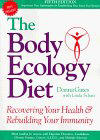
 FACT:
It is estimated that 80 million Americans suffer from candidiasis.
(The Body Ecology Diet - Donna Gates and Linda Schatz, B.E.D. Publications)
Candida, or candidiasis often goes hand in hand with serious illnesses such as Epstein-Barr virus, AIDS, and diabetes. FACT:
It is estimated that 80 million Americans suffer from candidiasis.
(The Body Ecology Diet - Donna Gates and Linda Schatz, B.E.D. Publications)
Candida, or candidiasis often goes hand in hand with serious illnesses such as Epstein-Barr virus, AIDS, and diabetes.
Are Probiotics Safe?
 Unlike most supplements,
probiotics don`t seem to have any side effects. A recent review identified
143 human clinical trials of probiotics between 1961 and 1998, involving
more than 7,500 subjects, with no adverse effects being reported. Unlike most supplements,
probiotics don`t seem to have any side effects. A recent review identified
143 human clinical trials of probiotics between 1961 and 1998, involving
more than 7,500 subjects, with no adverse effects being reported.
|
To Users in the U.S.:. Neither the information on this page,
nor this product,
have been evaluated by the U.S. Food & Drug
Administration. Therefore, this product is not intended to diagnose,
treat, cure or prevent any disease.
|
 Microflora Restore II -- Ingredients: Microflora Restore II -- Ingredients:
Prebiotic blend [Bioactive Leonardite, Norwegian kelp
(Ascophyllum nodosum), Bladderwrack (Fucus vesiculosus),
Oarweed (Laminaria digitata); "middle earth" mineral salts
from Ecuador)], Microflora Restore II Probiotic Blend (including
35 different strains of Arthrobacter, Azospirillum, Bacillus,
Bifidobacterium, Brevibacillus, Lactobacillus, Lysinibacillus,
Micrococcus, Pseudomonas, Rhodospirillum, and Streptomyces);
and Probiotic substrate (dextrose and/or wheat germ and sea salt).
 Click to enlarge either image below to view
the current label for each product.
Microflora Restore II
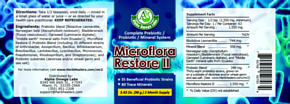 Microflora Acceler-X
Microflora Acceler-X

|